MMS773 Essay: Australian Sport Broadcasting Changes Analysis
VerifiedAdded on 2022/11/29
|21
|5891
|257
Essay
AI Summary
This essay examines the evolution of sport broadcasting, from its early days with radio to the current dominance of digital media and OTT platforms. It delves into the historical context, highlighting key milestones like the first live broadcasts and the impact of the internet. The paper analyzes the shift from traditional broadcasting to narrowcast media, focusing on the consumer escalation model and the implications for stakeholders in the Australian sports industry. It explores the role of OTT platforms like Netflix, and the impact of the internet in shaping the sports broadcasting sector. Furthermore, the essay discusses consumer dissatisfaction, including preferential, categorical, and linguistic aspects. Through a strategic analysis using Porter's 5 Forces and PESTEL analysis, along with a derived SWOT analysis, the essay provides a comprehensive understanding of the challenges and opportunities in the changing landscape of sport broadcasting, offering implications for organizations and the wider industry.
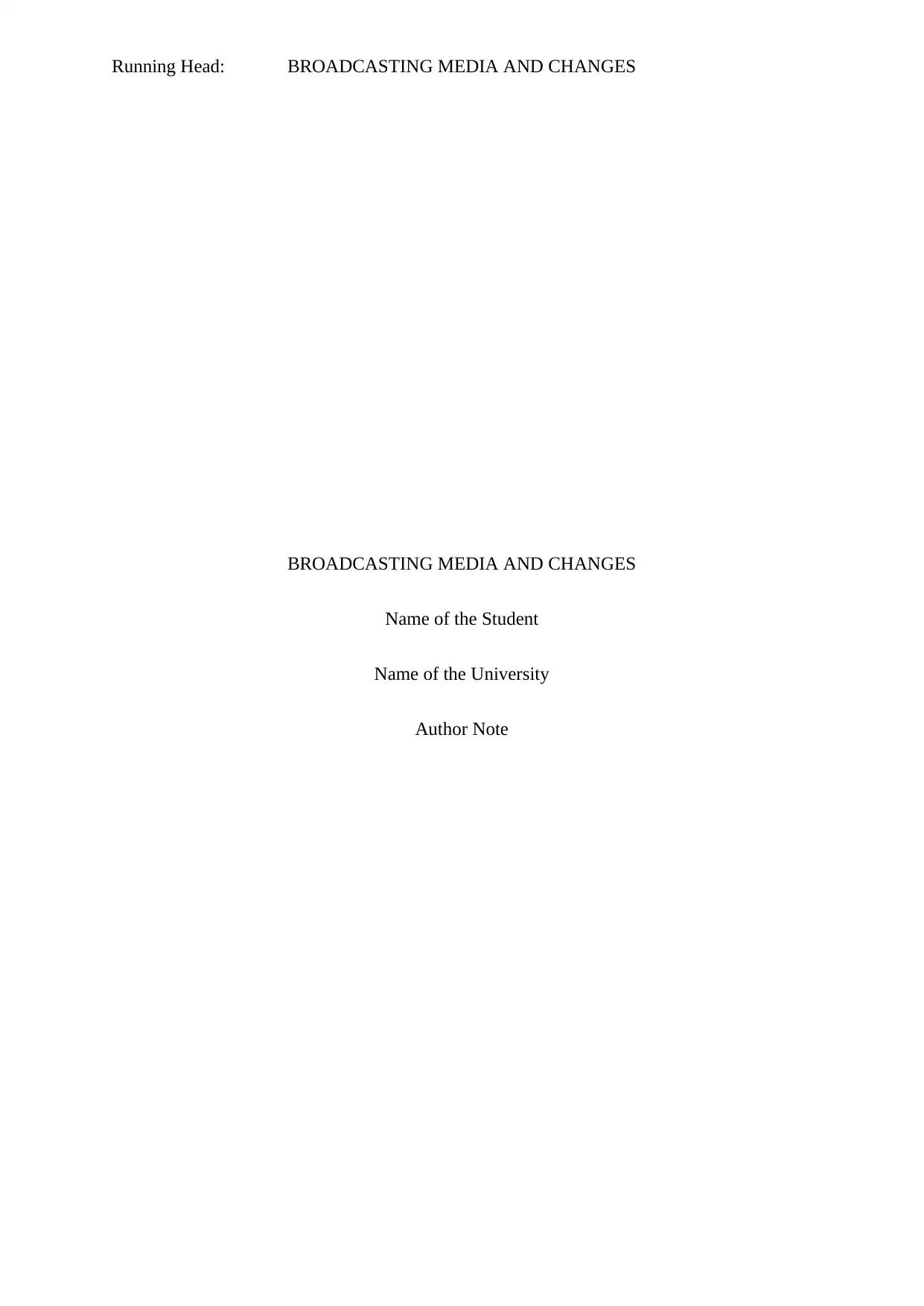
Running Head: BROADCASTING MEDIA AND CHANGES
BROADCASTING MEDIA AND CHANGES
Name of the Student
Name of the University
Author Note
BROADCASTING MEDIA AND CHANGES
Name of the Student
Name of the University
Author Note
Paraphrase This Document
Need a fresh take? Get an instant paraphrase of this document with our AI Paraphraser
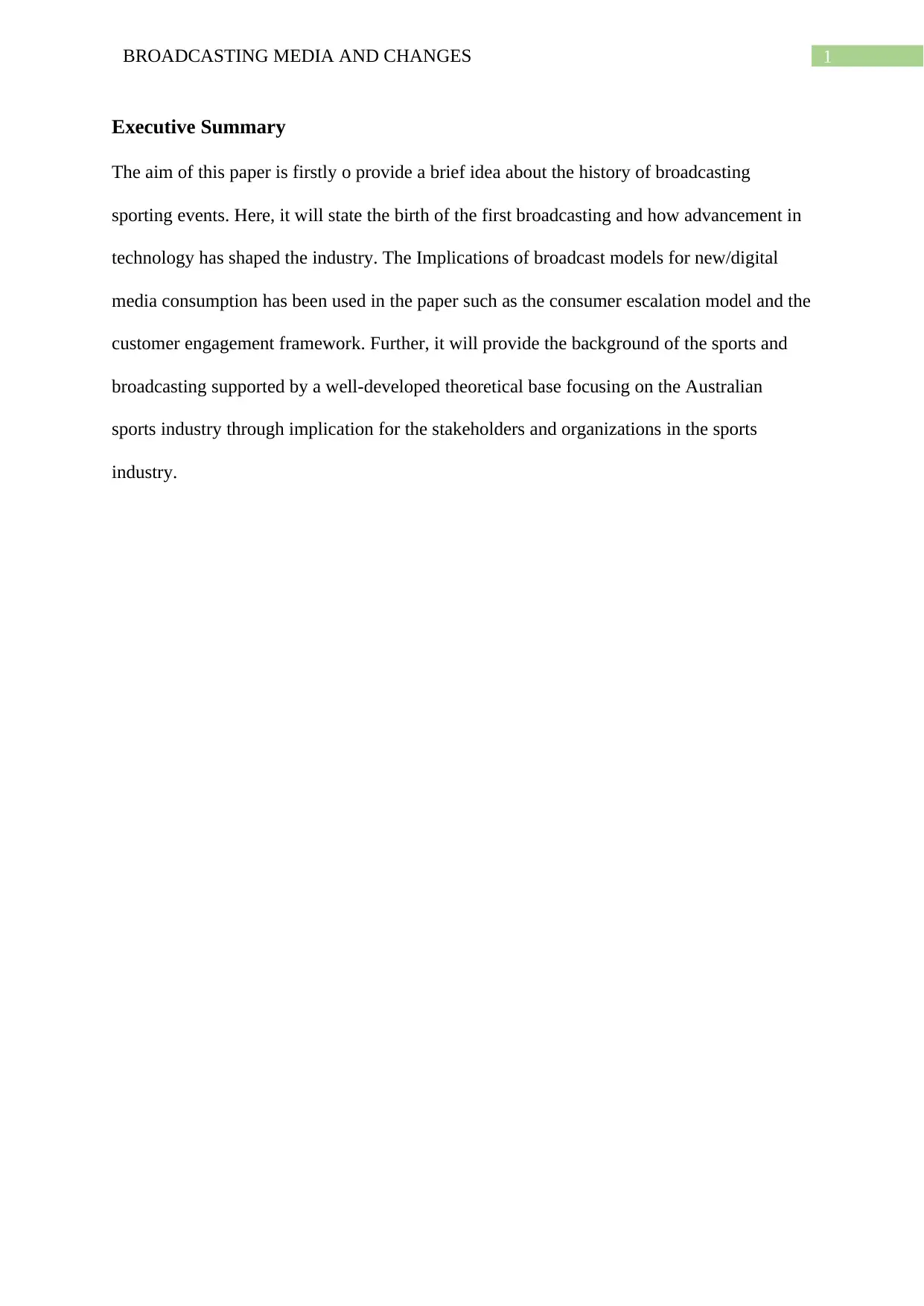
1BROADCASTING MEDIA AND CHANGES
Executive Summary
The aim of this paper is firstly o provide a brief idea about the history of broadcasting
sporting events. Here, it will state the birth of the first broadcasting and how advancement in
technology has shaped the industry. The Implications of broadcast models for new/digital
media consumption has been used in the paper such as the consumer escalation model and the
customer engagement framework. Further, it will provide the background of the sports and
broadcasting supported by a well-developed theoretical base focusing on the Australian
sports industry through implication for the stakeholders and organizations in the sports
industry.
Executive Summary
The aim of this paper is firstly o provide a brief idea about the history of broadcasting
sporting events. Here, it will state the birth of the first broadcasting and how advancement in
technology has shaped the industry. The Implications of broadcast models for new/digital
media consumption has been used in the paper such as the consumer escalation model and the
customer engagement framework. Further, it will provide the background of the sports and
broadcasting supported by a well-developed theoretical base focusing on the Australian
sports industry through implication for the stakeholders and organizations in the sports
industry.
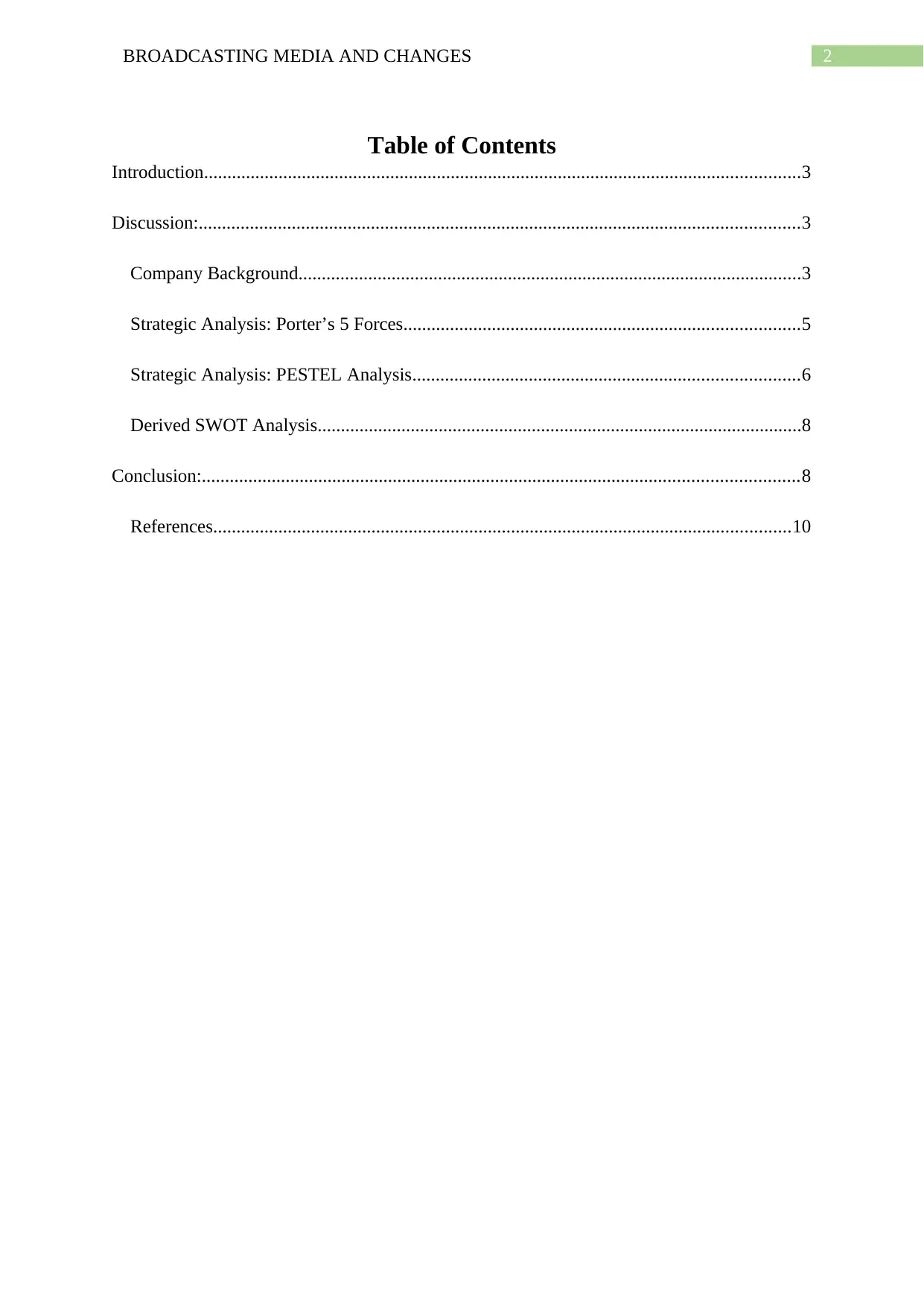
2BROADCASTING MEDIA AND CHANGES
Table of Contents
Introduction................................................................................................................................3
Discussion:.................................................................................................................................3
Company Background............................................................................................................3
Strategic Analysis: Porter’s 5 Forces.....................................................................................5
Strategic Analysis: PESTEL Analysis...................................................................................6
Derived SWOT Analysis........................................................................................................8
Conclusion:................................................................................................................................8
References............................................................................................................................10
Table of Contents
Introduction................................................................................................................................3
Discussion:.................................................................................................................................3
Company Background............................................................................................................3
Strategic Analysis: Porter’s 5 Forces.....................................................................................5
Strategic Analysis: PESTEL Analysis...................................................................................6
Derived SWOT Analysis........................................................................................................8
Conclusion:................................................................................................................................8
References............................................................................................................................10
⊘ This is a preview!⊘
Do you want full access?
Subscribe today to unlock all pages.

Trusted by 1+ million students worldwide
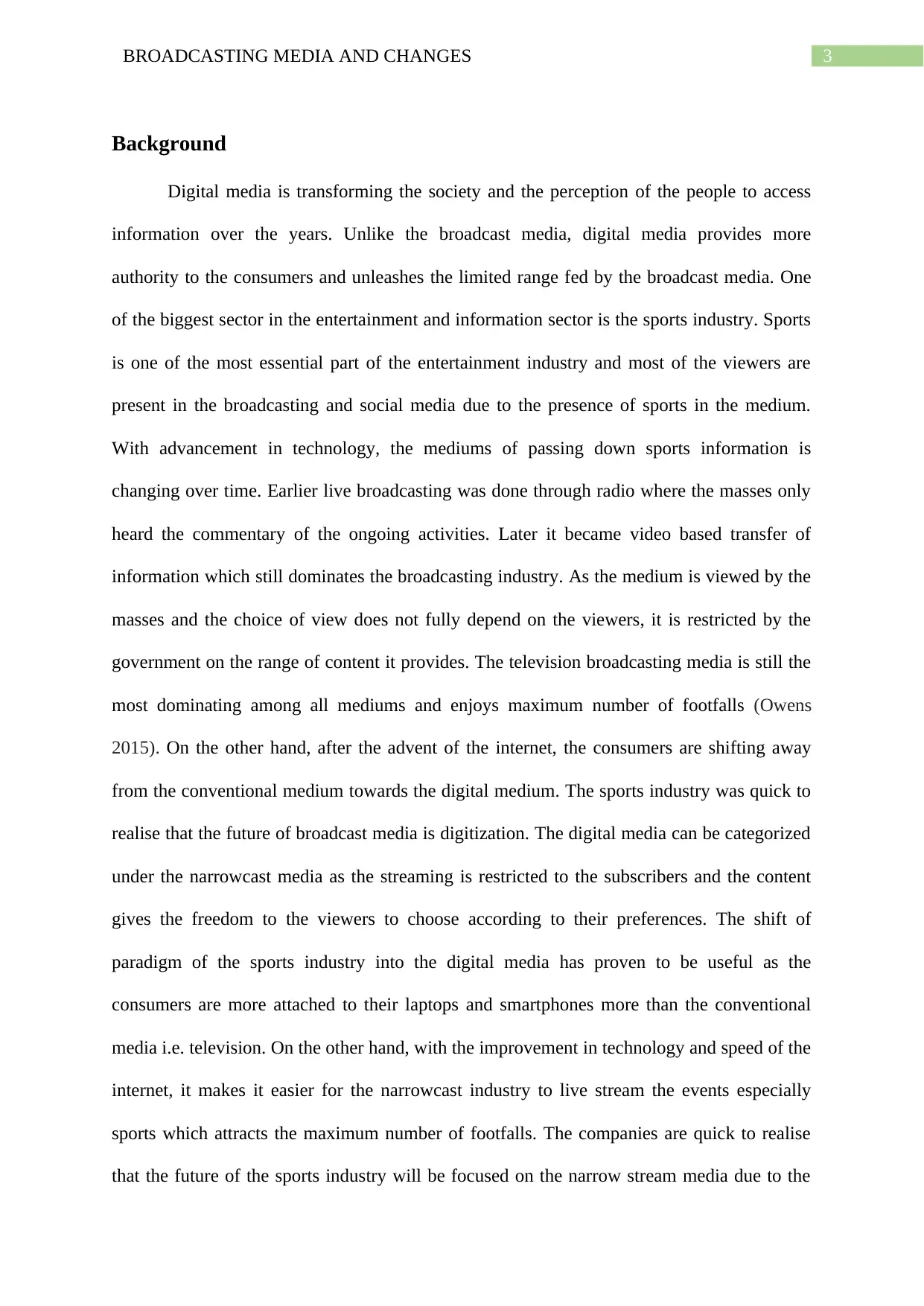
3BROADCASTING MEDIA AND CHANGES
Background
Digital media is transforming the society and the perception of the people to access
information over the years. Unlike the broadcast media, digital media provides more
authority to the consumers and unleashes the limited range fed by the broadcast media. One
of the biggest sector in the entertainment and information sector is the sports industry. Sports
is one of the most essential part of the entertainment industry and most of the viewers are
present in the broadcasting and social media due to the presence of sports in the medium.
With advancement in technology, the mediums of passing down sports information is
changing over time. Earlier live broadcasting was done through radio where the masses only
heard the commentary of the ongoing activities. Later it became video based transfer of
information which still dominates the broadcasting industry. As the medium is viewed by the
masses and the choice of view does not fully depend on the viewers, it is restricted by the
government on the range of content it provides. The television broadcasting media is still the
most dominating among all mediums and enjoys maximum number of footfalls (Owens
2015). On the other hand, after the advent of the internet, the consumers are shifting away
from the conventional medium towards the digital medium. The sports industry was quick to
realise that the future of broadcast media is digitization. The digital media can be categorized
under the narrowcast media as the streaming is restricted to the subscribers and the content
gives the freedom to the viewers to choose according to their preferences. The shift of
paradigm of the sports industry into the digital media has proven to be useful as the
consumers are more attached to their laptops and smartphones more than the conventional
media i.e. television. On the other hand, with the improvement in technology and speed of the
internet, it makes it easier for the narrowcast industry to live stream the events especially
sports which attracts the maximum number of footfalls. The companies are quick to realise
that the future of the sports industry will be focused on the narrow stream media due to the
Background
Digital media is transforming the society and the perception of the people to access
information over the years. Unlike the broadcast media, digital media provides more
authority to the consumers and unleashes the limited range fed by the broadcast media. One
of the biggest sector in the entertainment and information sector is the sports industry. Sports
is one of the most essential part of the entertainment industry and most of the viewers are
present in the broadcasting and social media due to the presence of sports in the medium.
With advancement in technology, the mediums of passing down sports information is
changing over time. Earlier live broadcasting was done through radio where the masses only
heard the commentary of the ongoing activities. Later it became video based transfer of
information which still dominates the broadcasting industry. As the medium is viewed by the
masses and the choice of view does not fully depend on the viewers, it is restricted by the
government on the range of content it provides. The television broadcasting media is still the
most dominating among all mediums and enjoys maximum number of footfalls (Owens
2015). On the other hand, after the advent of the internet, the consumers are shifting away
from the conventional medium towards the digital medium. The sports industry was quick to
realise that the future of broadcast media is digitization. The digital media can be categorized
under the narrowcast media as the streaming is restricted to the subscribers and the content
gives the freedom to the viewers to choose according to their preferences. The shift of
paradigm of the sports industry into the digital media has proven to be useful as the
consumers are more attached to their laptops and smartphones more than the conventional
media i.e. television. On the other hand, with the improvement in technology and speed of the
internet, it makes it easier for the narrowcast industry to live stream the events especially
sports which attracts the maximum number of footfalls. The companies are quick to realise
that the future of the sports industry will be focused on the narrow stream media due to the
Paraphrase This Document
Need a fresh take? Get an instant paraphrase of this document with our AI Paraphraser
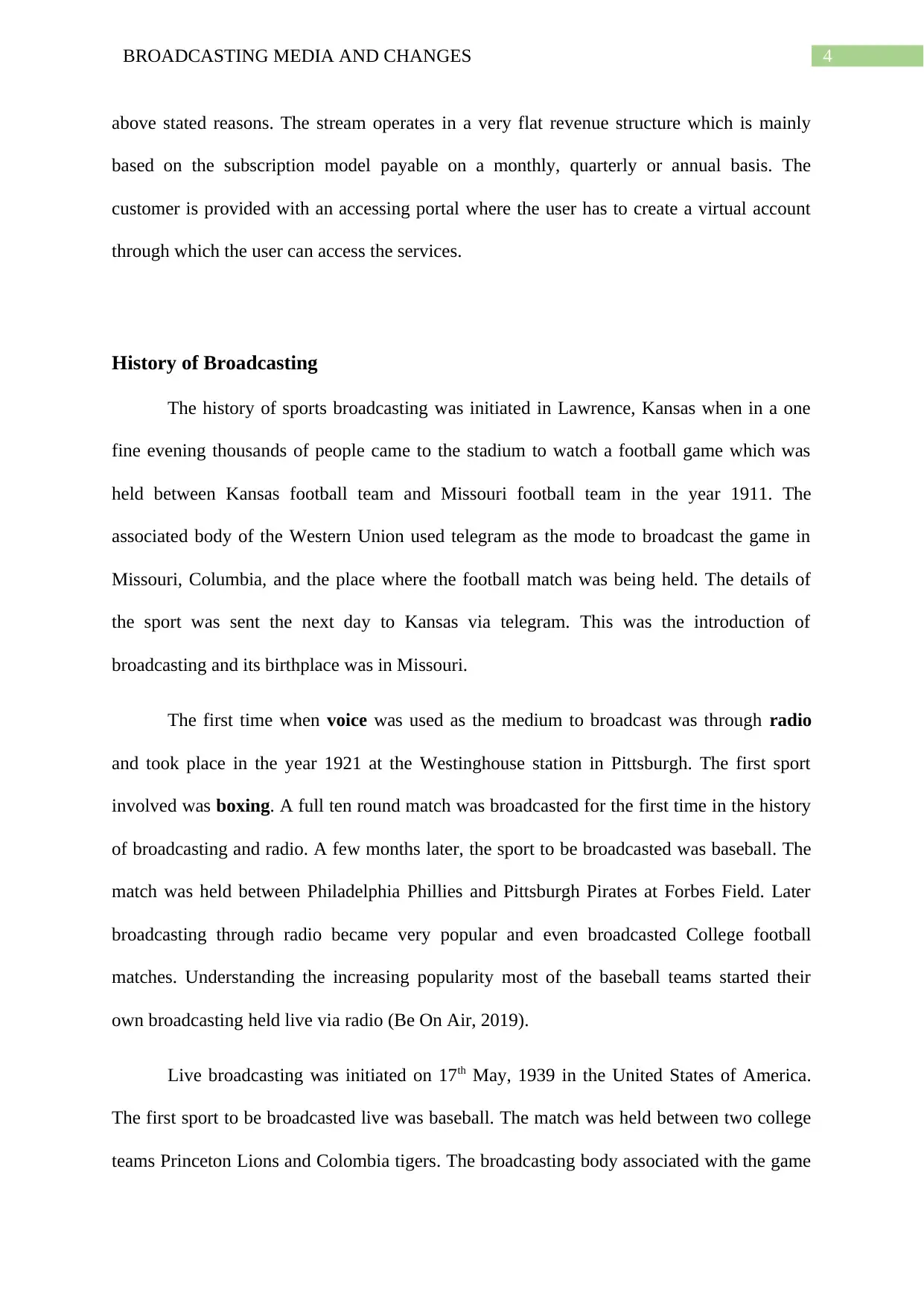
4BROADCASTING MEDIA AND CHANGES
above stated reasons. The stream operates in a very flat revenue structure which is mainly
based on the subscription model payable on a monthly, quarterly or annual basis. The
customer is provided with an accessing portal where the user has to create a virtual account
through which the user can access the services.
History of Broadcasting
The history of sports broadcasting was initiated in Lawrence, Kansas when in a one
fine evening thousands of people came to the stadium to watch a football game which was
held between Kansas football team and Missouri football team in the year 1911. The
associated body of the Western Union used telegram as the mode to broadcast the game in
Missouri, Columbia, and the place where the football match was being held. The details of
the sport was sent the next day to Kansas via telegram. This was the introduction of
broadcasting and its birthplace was in Missouri.
The first time when voice was used as the medium to broadcast was through radio
and took place in the year 1921 at the Westinghouse station in Pittsburgh. The first sport
involved was boxing. A full ten round match was broadcasted for the first time in the history
of broadcasting and radio. A few months later, the sport to be broadcasted was baseball. The
match was held between Philadelphia Phillies and Pittsburgh Pirates at Forbes Field. Later
broadcasting through radio became very popular and even broadcasted College football
matches. Understanding the increasing popularity most of the baseball teams started their
own broadcasting held live via radio (Be On Air, 2019).
Live broadcasting was initiated on 17th May, 1939 in the United States of America.
The first sport to be broadcasted live was baseball. The match was held between two college
teams Princeton Lions and Colombia tigers. The broadcasting body associated with the game
above stated reasons. The stream operates in a very flat revenue structure which is mainly
based on the subscription model payable on a monthly, quarterly or annual basis. The
customer is provided with an accessing portal where the user has to create a virtual account
through which the user can access the services.
History of Broadcasting
The history of sports broadcasting was initiated in Lawrence, Kansas when in a one
fine evening thousands of people came to the stadium to watch a football game which was
held between Kansas football team and Missouri football team in the year 1911. The
associated body of the Western Union used telegram as the mode to broadcast the game in
Missouri, Columbia, and the place where the football match was being held. The details of
the sport was sent the next day to Kansas via telegram. This was the introduction of
broadcasting and its birthplace was in Missouri.
The first time when voice was used as the medium to broadcast was through radio
and took place in the year 1921 at the Westinghouse station in Pittsburgh. The first sport
involved was boxing. A full ten round match was broadcasted for the first time in the history
of broadcasting and radio. A few months later, the sport to be broadcasted was baseball. The
match was held between Philadelphia Phillies and Pittsburgh Pirates at Forbes Field. Later
broadcasting through radio became very popular and even broadcasted College football
matches. Understanding the increasing popularity most of the baseball teams started their
own broadcasting held live via radio (Be On Air, 2019).
Live broadcasting was initiated on 17th May, 1939 in the United States of America.
The first sport to be broadcasted live was baseball. The match was held between two college
teams Princeton Lions and Colombia tigers. The broadcasting body associated with the game
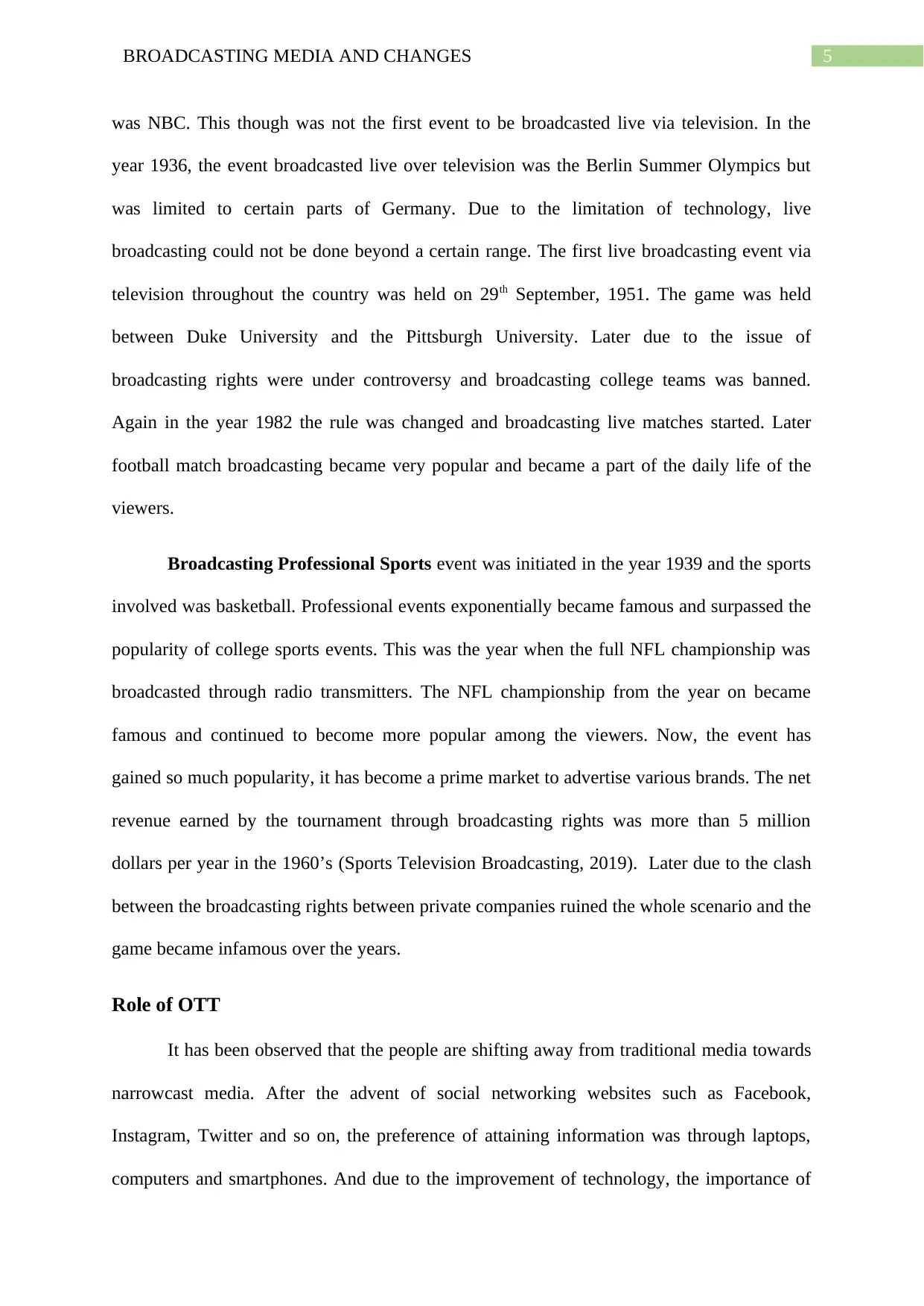
5BROADCASTING MEDIA AND CHANGES
was NBC. This though was not the first event to be broadcasted live via television. In the
year 1936, the event broadcasted live over television was the Berlin Summer Olympics but
was limited to certain parts of Germany. Due to the limitation of technology, live
broadcasting could not be done beyond a certain range. The first live broadcasting event via
television throughout the country was held on 29th September, 1951. The game was held
between Duke University and the Pittsburgh University. Later due to the issue of
broadcasting rights were under controversy and broadcasting college teams was banned.
Again in the year 1982 the rule was changed and broadcasting live matches started. Later
football match broadcasting became very popular and became a part of the daily life of the
viewers.
Broadcasting Professional Sports event was initiated in the year 1939 and the sports
involved was basketball. Professional events exponentially became famous and surpassed the
popularity of college sports events. This was the year when the full NFL championship was
broadcasted through radio transmitters. The NFL championship from the year on became
famous and continued to become more popular among the viewers. Now, the event has
gained so much popularity, it has become a prime market to advertise various brands. The net
revenue earned by the tournament through broadcasting rights was more than 5 million
dollars per year in the 1960’s (Sports Television Broadcasting, 2019). Later due to the clash
between the broadcasting rights between private companies ruined the whole scenario and the
game became infamous over the years.
Role of OTT
It has been observed that the people are shifting away from traditional media towards
narrowcast media. After the advent of social networking websites such as Facebook,
Instagram, Twitter and so on, the preference of attaining information was through laptops,
computers and smartphones. And due to the improvement of technology, the importance of
was NBC. This though was not the first event to be broadcasted live via television. In the
year 1936, the event broadcasted live over television was the Berlin Summer Olympics but
was limited to certain parts of Germany. Due to the limitation of technology, live
broadcasting could not be done beyond a certain range. The first live broadcasting event via
television throughout the country was held on 29th September, 1951. The game was held
between Duke University and the Pittsburgh University. Later due to the issue of
broadcasting rights were under controversy and broadcasting college teams was banned.
Again in the year 1982 the rule was changed and broadcasting live matches started. Later
football match broadcasting became very popular and became a part of the daily life of the
viewers.
Broadcasting Professional Sports event was initiated in the year 1939 and the sports
involved was basketball. Professional events exponentially became famous and surpassed the
popularity of college sports events. This was the year when the full NFL championship was
broadcasted through radio transmitters. The NFL championship from the year on became
famous and continued to become more popular among the viewers. Now, the event has
gained so much popularity, it has become a prime market to advertise various brands. The net
revenue earned by the tournament through broadcasting rights was more than 5 million
dollars per year in the 1960’s (Sports Television Broadcasting, 2019). Later due to the clash
between the broadcasting rights between private companies ruined the whole scenario and the
game became infamous over the years.
Role of OTT
It has been observed that the people are shifting away from traditional media towards
narrowcast media. After the advent of social networking websites such as Facebook,
Instagram, Twitter and so on, the preference of attaining information was through laptops,
computers and smartphones. And due to the improvement of technology, the importance of
⊘ This is a preview!⊘
Do you want full access?
Subscribe today to unlock all pages.

Trusted by 1+ million students worldwide
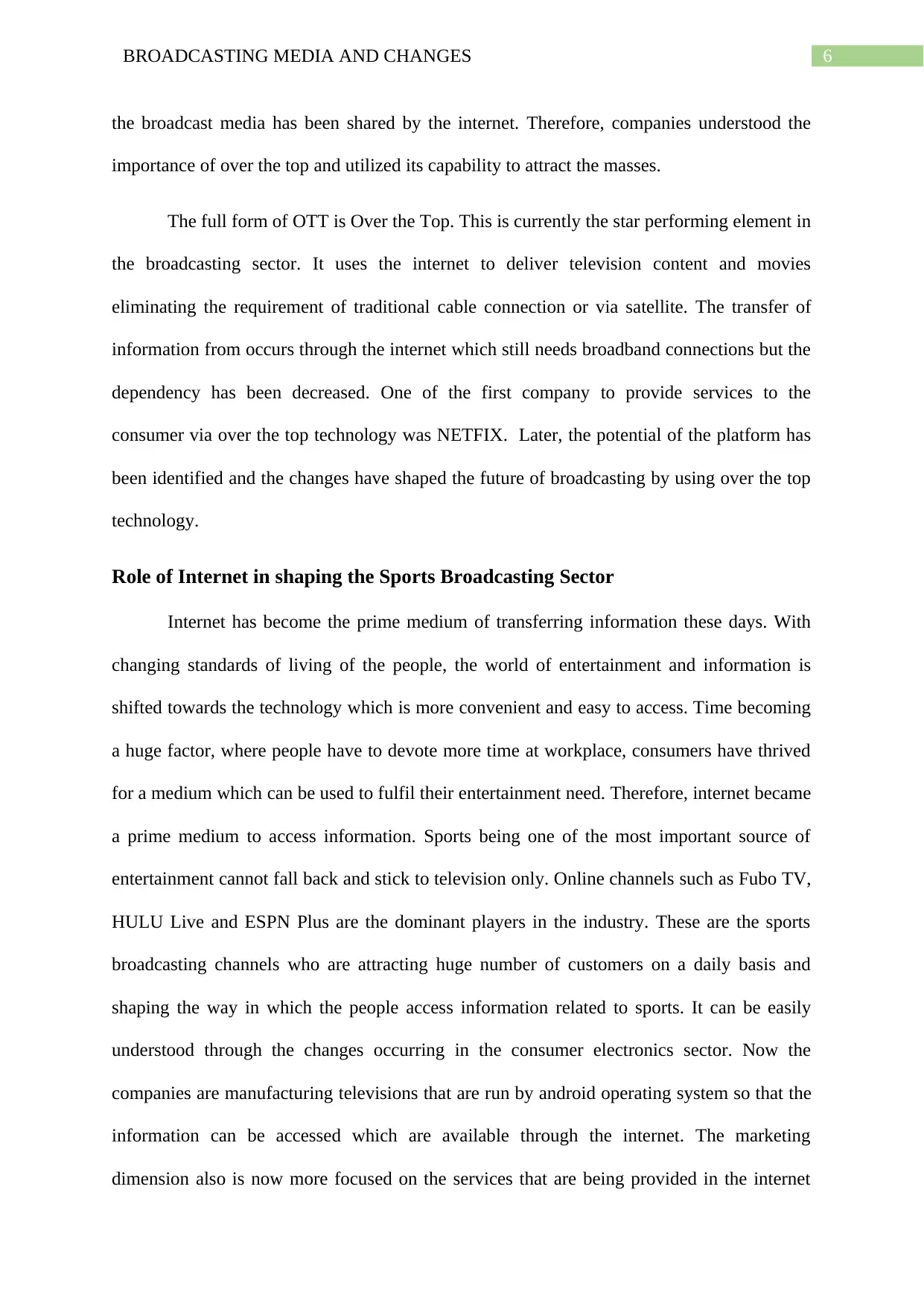
6BROADCASTING MEDIA AND CHANGES
the broadcast media has been shared by the internet. Therefore, companies understood the
importance of over the top and utilized its capability to attract the masses.
The full form of OTT is Over the Top. This is currently the star performing element in
the broadcasting sector. It uses the internet to deliver television content and movies
eliminating the requirement of traditional cable connection or via satellite. The transfer of
information from occurs through the internet which still needs broadband connections but the
dependency has been decreased. One of the first company to provide services to the
consumer via over the top technology was NETFIX. Later, the potential of the platform has
been identified and the changes have shaped the future of broadcasting by using over the top
technology.
Role of Internet in shaping the Sports Broadcasting Sector
Internet has become the prime medium of transferring information these days. With
changing standards of living of the people, the world of entertainment and information is
shifted towards the technology which is more convenient and easy to access. Time becoming
a huge factor, where people have to devote more time at workplace, consumers have thrived
for a medium which can be used to fulfil their entertainment need. Therefore, internet became
a prime medium to access information. Sports being one of the most important source of
entertainment cannot fall back and stick to television only. Online channels such as Fubo TV,
HULU Live and ESPN Plus are the dominant players in the industry. These are the sports
broadcasting channels who are attracting huge number of customers on a daily basis and
shaping the way in which the people access information related to sports. It can be easily
understood through the changes occurring in the consumer electronics sector. Now the
companies are manufacturing televisions that are run by android operating system so that the
information can be accessed which are available through the internet. The marketing
dimension also is now more focused on the services that are being provided in the internet
the broadcast media has been shared by the internet. Therefore, companies understood the
importance of over the top and utilized its capability to attract the masses.
The full form of OTT is Over the Top. This is currently the star performing element in
the broadcasting sector. It uses the internet to deliver television content and movies
eliminating the requirement of traditional cable connection or via satellite. The transfer of
information from occurs through the internet which still needs broadband connections but the
dependency has been decreased. One of the first company to provide services to the
consumer via over the top technology was NETFIX. Later, the potential of the platform has
been identified and the changes have shaped the future of broadcasting by using over the top
technology.
Role of Internet in shaping the Sports Broadcasting Sector
Internet has become the prime medium of transferring information these days. With
changing standards of living of the people, the world of entertainment and information is
shifted towards the technology which is more convenient and easy to access. Time becoming
a huge factor, where people have to devote more time at workplace, consumers have thrived
for a medium which can be used to fulfil their entertainment need. Therefore, internet became
a prime medium to access information. Sports being one of the most important source of
entertainment cannot fall back and stick to television only. Online channels such as Fubo TV,
HULU Live and ESPN Plus are the dominant players in the industry. These are the sports
broadcasting channels who are attracting huge number of customers on a daily basis and
shaping the way in which the people access information related to sports. It can be easily
understood through the changes occurring in the consumer electronics sector. Now the
companies are manufacturing televisions that are run by android operating system so that the
information can be accessed which are available through the internet. The marketing
dimension also is now more focused on the services that are being provided in the internet
Paraphrase This Document
Need a fresh take? Get an instant paraphrase of this document with our AI Paraphraser
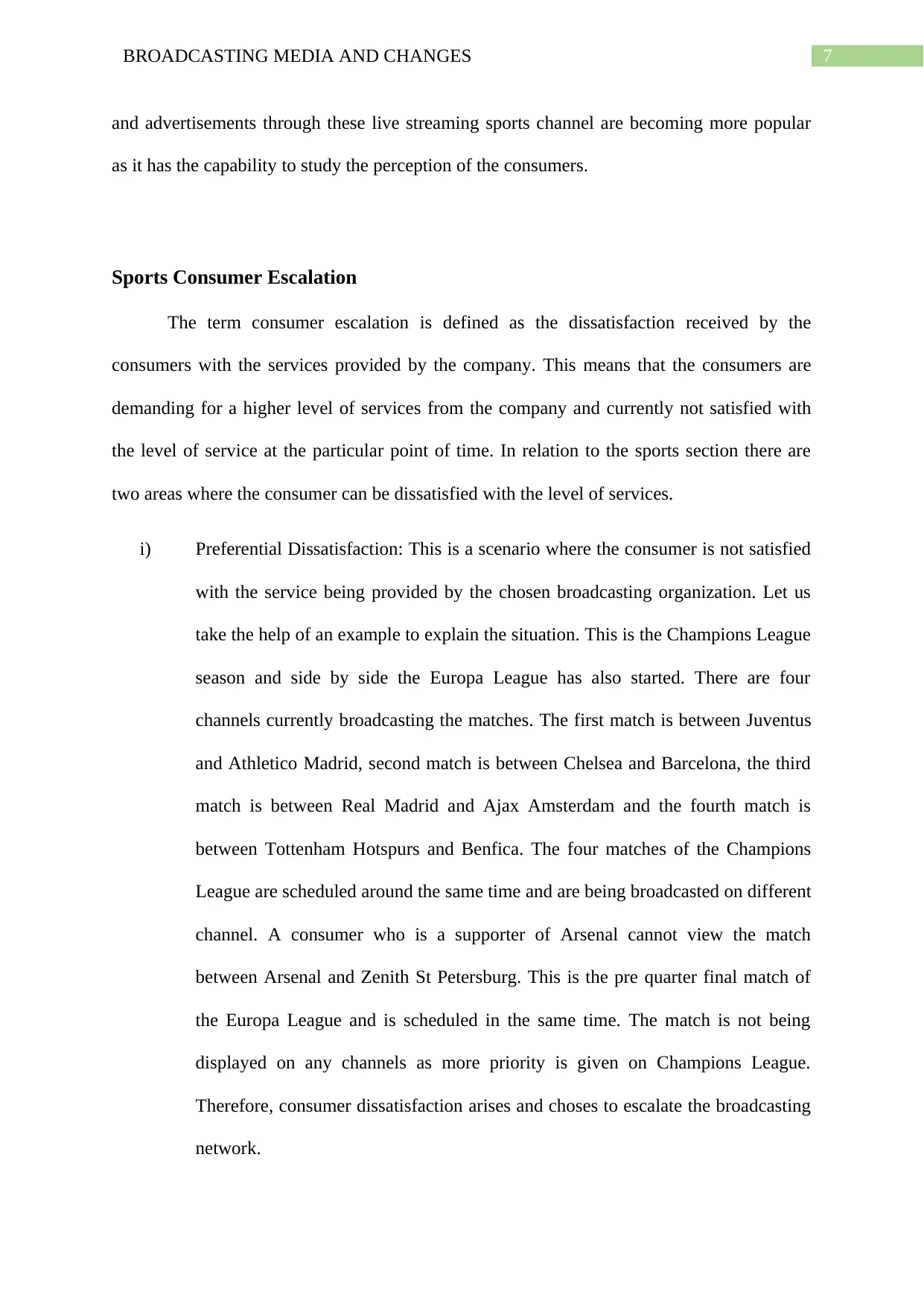
7BROADCASTING MEDIA AND CHANGES
and advertisements through these live streaming sports channel are becoming more popular
as it has the capability to study the perception of the consumers.
Sports Consumer Escalation
The term consumer escalation is defined as the dissatisfaction received by the
consumers with the services provided by the company. This means that the consumers are
demanding for a higher level of services from the company and currently not satisfied with
the level of service at the particular point of time. In relation to the sports section there are
two areas where the consumer can be dissatisfied with the level of services.
i) Preferential Dissatisfaction: This is a scenario where the consumer is not satisfied
with the service being provided by the chosen broadcasting organization. Let us
take the help of an example to explain the situation. This is the Champions League
season and side by side the Europa League has also started. There are four
channels currently broadcasting the matches. The first match is between Juventus
and Athletico Madrid, second match is between Chelsea and Barcelona, the third
match is between Real Madrid and Ajax Amsterdam and the fourth match is
between Tottenham Hotspurs and Benfica. The four matches of the Champions
League are scheduled around the same time and are being broadcasted on different
channel. A consumer who is a supporter of Arsenal cannot view the match
between Arsenal and Zenith St Petersburg. This is the pre quarter final match of
the Europa League and is scheduled in the same time. The match is not being
displayed on any channels as more priority is given on Champions League.
Therefore, consumer dissatisfaction arises and choses to escalate the broadcasting
network.
and advertisements through these live streaming sports channel are becoming more popular
as it has the capability to study the perception of the consumers.
Sports Consumer Escalation
The term consumer escalation is defined as the dissatisfaction received by the
consumers with the services provided by the company. This means that the consumers are
demanding for a higher level of services from the company and currently not satisfied with
the level of service at the particular point of time. In relation to the sports section there are
two areas where the consumer can be dissatisfied with the level of services.
i) Preferential Dissatisfaction: This is a scenario where the consumer is not satisfied
with the service being provided by the chosen broadcasting organization. Let us
take the help of an example to explain the situation. This is the Champions League
season and side by side the Europa League has also started. There are four
channels currently broadcasting the matches. The first match is between Juventus
and Athletico Madrid, second match is between Chelsea and Barcelona, the third
match is between Real Madrid and Ajax Amsterdam and the fourth match is
between Tottenham Hotspurs and Benfica. The four matches of the Champions
League are scheduled around the same time and are being broadcasted on different
channel. A consumer who is a supporter of Arsenal cannot view the match
between Arsenal and Zenith St Petersburg. This is the pre quarter final match of
the Europa League and is scheduled in the same time. The match is not being
displayed on any channels as more priority is given on Champions League.
Therefore, consumer dissatisfaction arises and choses to escalate the broadcasting
network.
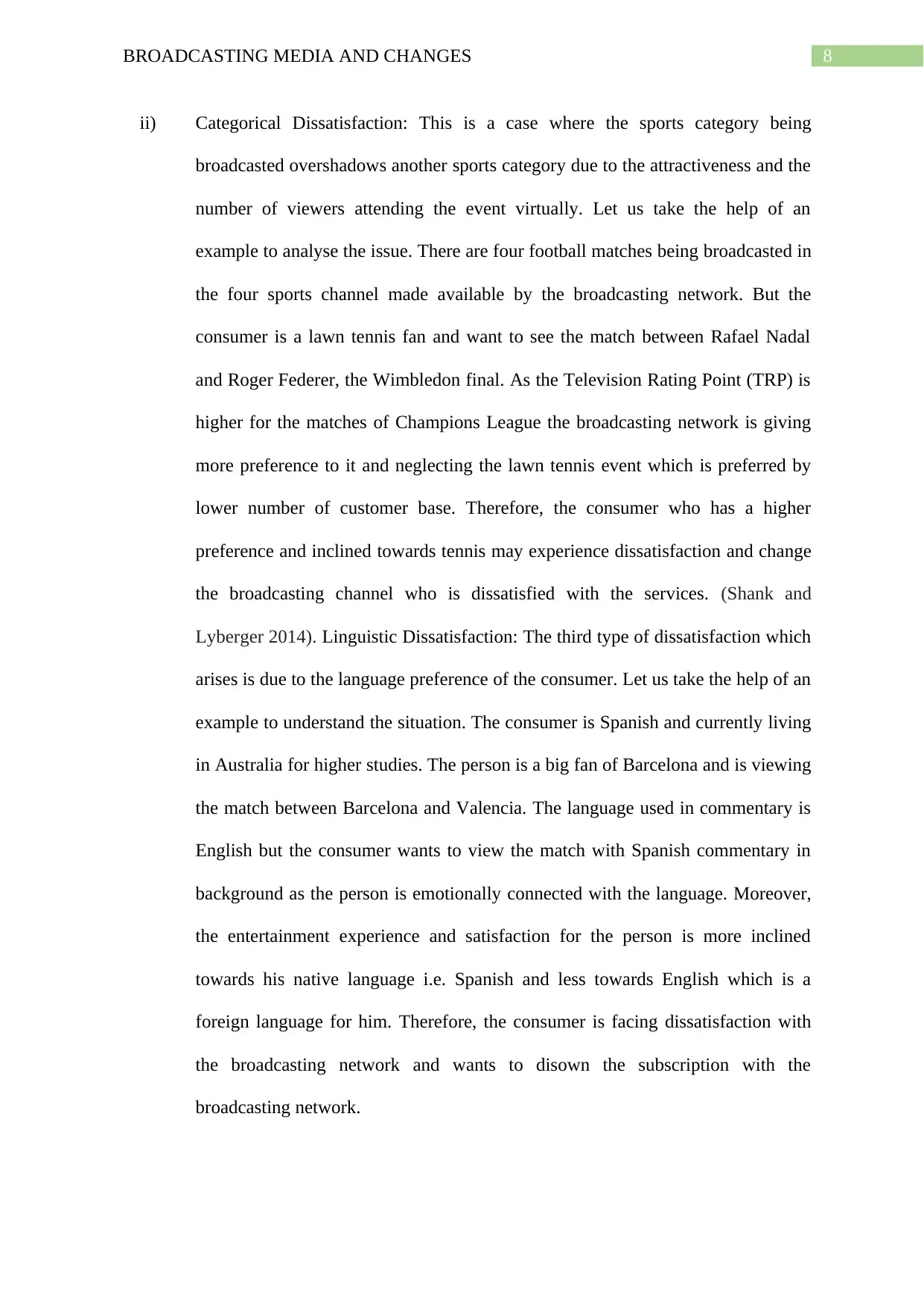
8BROADCASTING MEDIA AND CHANGES
ii) Categorical Dissatisfaction: This is a case where the sports category being
broadcasted overshadows another sports category due to the attractiveness and the
number of viewers attending the event virtually. Let us take the help of an
example to analyse the issue. There are four football matches being broadcasted in
the four sports channel made available by the broadcasting network. But the
consumer is a lawn tennis fan and want to see the match between Rafael Nadal
and Roger Federer, the Wimbledon final. As the Television Rating Point (TRP) is
higher for the matches of Champions League the broadcasting network is giving
more preference to it and neglecting the lawn tennis event which is preferred by
lower number of customer base. Therefore, the consumer who has a higher
preference and inclined towards tennis may experience dissatisfaction and change
the broadcasting channel who is dissatisfied with the services. (Shank and
Lyberger 2014). Linguistic Dissatisfaction: The third type of dissatisfaction which
arises is due to the language preference of the consumer. Let us take the help of an
example to understand the situation. The consumer is Spanish and currently living
in Australia for higher studies. The person is a big fan of Barcelona and is viewing
the match between Barcelona and Valencia. The language used in commentary is
English but the consumer wants to view the match with Spanish commentary in
background as the person is emotionally connected with the language. Moreover,
the entertainment experience and satisfaction for the person is more inclined
towards his native language i.e. Spanish and less towards English which is a
foreign language for him. Therefore, the consumer is facing dissatisfaction with
the broadcasting network and wants to disown the subscription with the
broadcasting network.
ii) Categorical Dissatisfaction: This is a case where the sports category being
broadcasted overshadows another sports category due to the attractiveness and the
number of viewers attending the event virtually. Let us take the help of an
example to analyse the issue. There are four football matches being broadcasted in
the four sports channel made available by the broadcasting network. But the
consumer is a lawn tennis fan and want to see the match between Rafael Nadal
and Roger Federer, the Wimbledon final. As the Television Rating Point (TRP) is
higher for the matches of Champions League the broadcasting network is giving
more preference to it and neglecting the lawn tennis event which is preferred by
lower number of customer base. Therefore, the consumer who has a higher
preference and inclined towards tennis may experience dissatisfaction and change
the broadcasting channel who is dissatisfied with the services. (Shank and
Lyberger 2014). Linguistic Dissatisfaction: The third type of dissatisfaction which
arises is due to the language preference of the consumer. Let us take the help of an
example to understand the situation. The consumer is Spanish and currently living
in Australia for higher studies. The person is a big fan of Barcelona and is viewing
the match between Barcelona and Valencia. The language used in commentary is
English but the consumer wants to view the match with Spanish commentary in
background as the person is emotionally connected with the language. Moreover,
the entertainment experience and satisfaction for the person is more inclined
towards his native language i.e. Spanish and less towards English which is a
foreign language for him. Therefore, the consumer is facing dissatisfaction with
the broadcasting network and wants to disown the subscription with the
broadcasting network.
⊘ This is a preview!⊘
Do you want full access?
Subscribe today to unlock all pages.

Trusted by 1+ million students worldwide
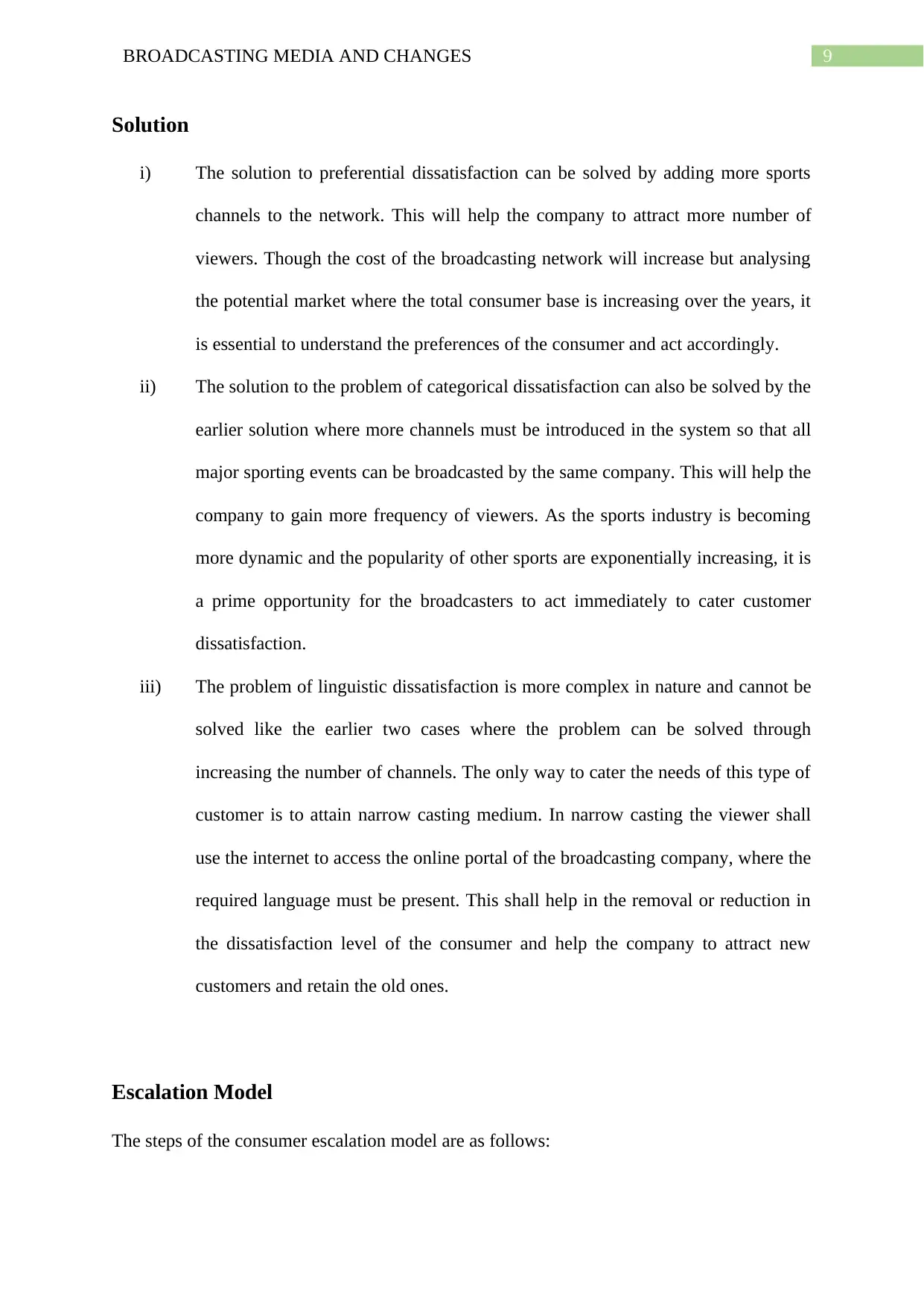
9BROADCASTING MEDIA AND CHANGES
Solution
i) The solution to preferential dissatisfaction can be solved by adding more sports
channels to the network. This will help the company to attract more number of
viewers. Though the cost of the broadcasting network will increase but analysing
the potential market where the total consumer base is increasing over the years, it
is essential to understand the preferences of the consumer and act accordingly.
ii) The solution to the problem of categorical dissatisfaction can also be solved by the
earlier solution where more channels must be introduced in the system so that all
major sporting events can be broadcasted by the same company. This will help the
company to gain more frequency of viewers. As the sports industry is becoming
more dynamic and the popularity of other sports are exponentially increasing, it is
a prime opportunity for the broadcasters to act immediately to cater customer
dissatisfaction.
iii) The problem of linguistic dissatisfaction is more complex in nature and cannot be
solved like the earlier two cases where the problem can be solved through
increasing the number of channels. The only way to cater the needs of this type of
customer is to attain narrow casting medium. In narrow casting the viewer shall
use the internet to access the online portal of the broadcasting company, where the
required language must be present. This shall help in the removal or reduction in
the dissatisfaction level of the consumer and help the company to attract new
customers and retain the old ones.
Escalation Model
The steps of the consumer escalation model are as follows:
Solution
i) The solution to preferential dissatisfaction can be solved by adding more sports
channels to the network. This will help the company to attract more number of
viewers. Though the cost of the broadcasting network will increase but analysing
the potential market where the total consumer base is increasing over the years, it
is essential to understand the preferences of the consumer and act accordingly.
ii) The solution to the problem of categorical dissatisfaction can also be solved by the
earlier solution where more channels must be introduced in the system so that all
major sporting events can be broadcasted by the same company. This will help the
company to gain more frequency of viewers. As the sports industry is becoming
more dynamic and the popularity of other sports are exponentially increasing, it is
a prime opportunity for the broadcasters to act immediately to cater customer
dissatisfaction.
iii) The problem of linguistic dissatisfaction is more complex in nature and cannot be
solved like the earlier two cases where the problem can be solved through
increasing the number of channels. The only way to cater the needs of this type of
customer is to attain narrow casting medium. In narrow casting the viewer shall
use the internet to access the online portal of the broadcasting company, where the
required language must be present. This shall help in the removal or reduction in
the dissatisfaction level of the consumer and help the company to attract new
customers and retain the old ones.
Escalation Model
The steps of the consumer escalation model are as follows:
Paraphrase This Document
Need a fresh take? Get an instant paraphrase of this document with our AI Paraphraser
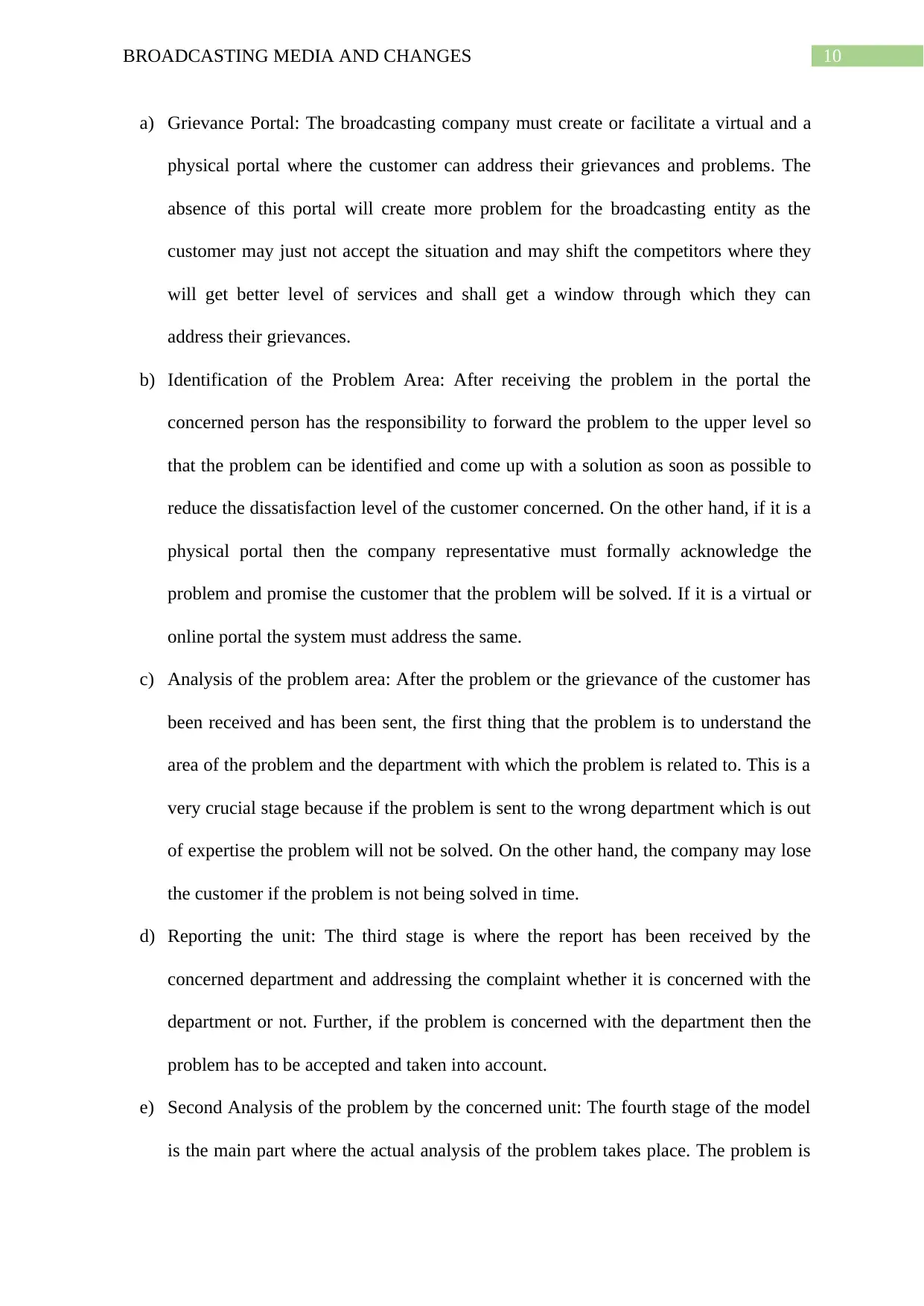
10BROADCASTING MEDIA AND CHANGES
a) Grievance Portal: The broadcasting company must create or facilitate a virtual and a
physical portal where the customer can address their grievances and problems. The
absence of this portal will create more problem for the broadcasting entity as the
customer may just not accept the situation and may shift the competitors where they
will get better level of services and shall get a window through which they can
address their grievances.
b) Identification of the Problem Area: After receiving the problem in the portal the
concerned person has the responsibility to forward the problem to the upper level so
that the problem can be identified and come up with a solution as soon as possible to
reduce the dissatisfaction level of the customer concerned. On the other hand, if it is a
physical portal then the company representative must formally acknowledge the
problem and promise the customer that the problem will be solved. If it is a virtual or
online portal the system must address the same.
c) Analysis of the problem area: After the problem or the grievance of the customer has
been received and has been sent, the first thing that the problem is to understand the
area of the problem and the department with which the problem is related to. This is a
very crucial stage because if the problem is sent to the wrong department which is out
of expertise the problem will not be solved. On the other hand, the company may lose
the customer if the problem is not being solved in time.
d) Reporting the unit: The third stage is where the report has been received by the
concerned department and addressing the complaint whether it is concerned with the
department or not. Further, if the problem is concerned with the department then the
problem has to be accepted and taken into account.
e) Second Analysis of the problem by the concerned unit: The fourth stage of the model
is the main part where the actual analysis of the problem takes place. The problem is
a) Grievance Portal: The broadcasting company must create or facilitate a virtual and a
physical portal where the customer can address their grievances and problems. The
absence of this portal will create more problem for the broadcasting entity as the
customer may just not accept the situation and may shift the competitors where they
will get better level of services and shall get a window through which they can
address their grievances.
b) Identification of the Problem Area: After receiving the problem in the portal the
concerned person has the responsibility to forward the problem to the upper level so
that the problem can be identified and come up with a solution as soon as possible to
reduce the dissatisfaction level of the customer concerned. On the other hand, if it is a
physical portal then the company representative must formally acknowledge the
problem and promise the customer that the problem will be solved. If it is a virtual or
online portal the system must address the same.
c) Analysis of the problem area: After the problem or the grievance of the customer has
been received and has been sent, the first thing that the problem is to understand the
area of the problem and the department with which the problem is related to. This is a
very crucial stage because if the problem is sent to the wrong department which is out
of expertise the problem will not be solved. On the other hand, the company may lose
the customer if the problem is not being solved in time.
d) Reporting the unit: The third stage is where the report has been received by the
concerned department and addressing the complaint whether it is concerned with the
department or not. Further, if the problem is concerned with the department then the
problem has to be accepted and taken into account.
e) Second Analysis of the problem by the concerned unit: The fourth stage of the model
is the main part where the actual analysis of the problem takes place. The problem is
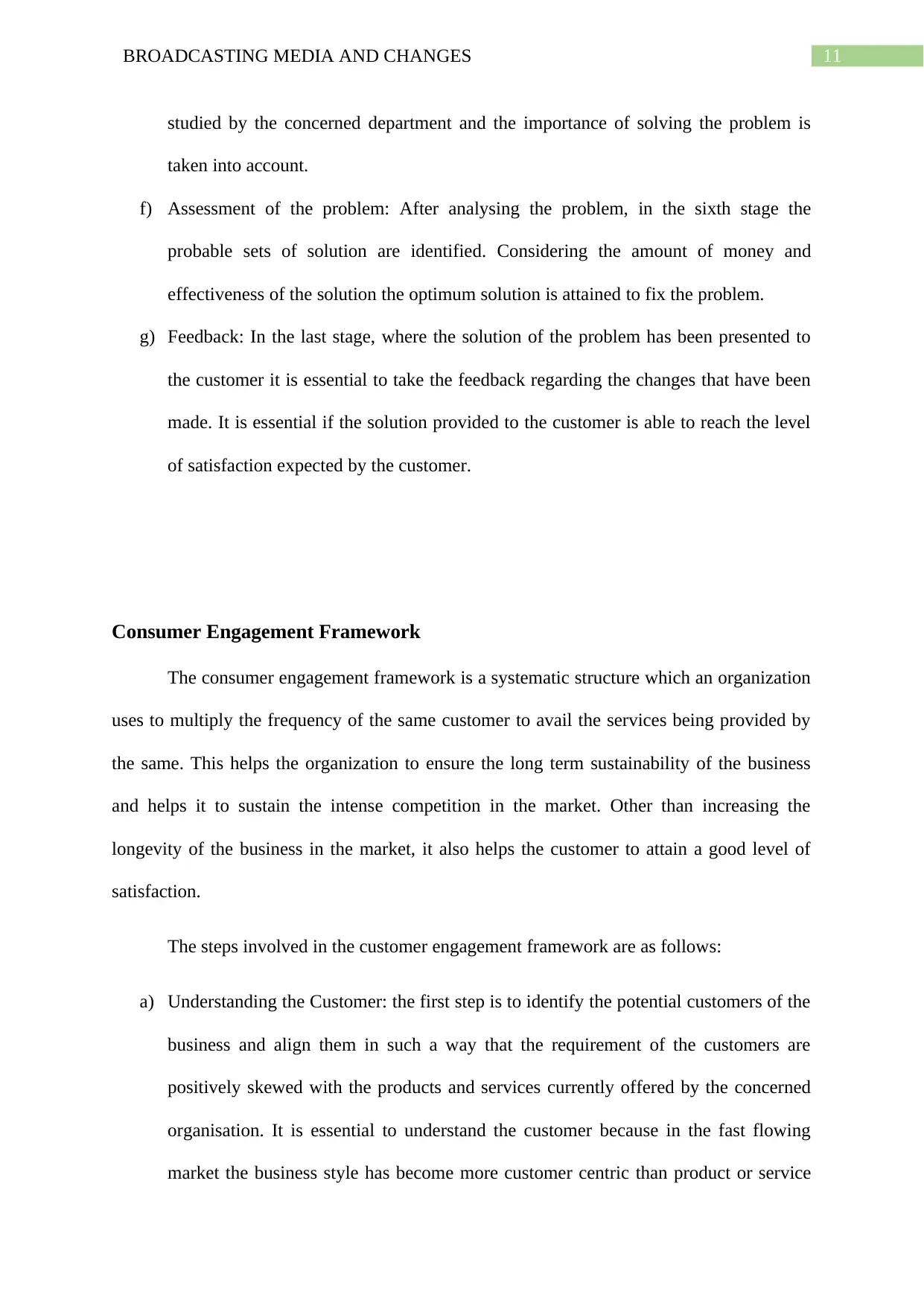
11BROADCASTING MEDIA AND CHANGES
studied by the concerned department and the importance of solving the problem is
taken into account.
f) Assessment of the problem: After analysing the problem, in the sixth stage the
probable sets of solution are identified. Considering the amount of money and
effectiveness of the solution the optimum solution is attained to fix the problem.
g) Feedback: In the last stage, where the solution of the problem has been presented to
the customer it is essential to take the feedback regarding the changes that have been
made. It is essential if the solution provided to the customer is able to reach the level
of satisfaction expected by the customer.
Consumer Engagement Framework
The consumer engagement framework is a systematic structure which an organization
uses to multiply the frequency of the same customer to avail the services being provided by
the same. This helps the organization to ensure the long term sustainability of the business
and helps it to sustain the intense competition in the market. Other than increasing the
longevity of the business in the market, it also helps the customer to attain a good level of
satisfaction.
The steps involved in the customer engagement framework are as follows:
a) Understanding the Customer: the first step is to identify the potential customers of the
business and align them in such a way that the requirement of the customers are
positively skewed with the products and services currently offered by the concerned
organisation. It is essential to understand the customer because in the fast flowing
market the business style has become more customer centric than product or service
studied by the concerned department and the importance of solving the problem is
taken into account.
f) Assessment of the problem: After analysing the problem, in the sixth stage the
probable sets of solution are identified. Considering the amount of money and
effectiveness of the solution the optimum solution is attained to fix the problem.
g) Feedback: In the last stage, where the solution of the problem has been presented to
the customer it is essential to take the feedback regarding the changes that have been
made. It is essential if the solution provided to the customer is able to reach the level
of satisfaction expected by the customer.
Consumer Engagement Framework
The consumer engagement framework is a systematic structure which an organization
uses to multiply the frequency of the same customer to avail the services being provided by
the same. This helps the organization to ensure the long term sustainability of the business
and helps it to sustain the intense competition in the market. Other than increasing the
longevity of the business in the market, it also helps the customer to attain a good level of
satisfaction.
The steps involved in the customer engagement framework are as follows:
a) Understanding the Customer: the first step is to identify the potential customers of the
business and align them in such a way that the requirement of the customers are
positively skewed with the products and services currently offered by the concerned
organisation. It is essential to understand the customer because in the fast flowing
market the business style has become more customer centric than product or service
⊘ This is a preview!⊘
Do you want full access?
Subscribe today to unlock all pages.

Trusted by 1+ million students worldwide
1 out of 21
Your All-in-One AI-Powered Toolkit for Academic Success.
+13062052269
info@desklib.com
Available 24*7 on WhatsApp / Email
![[object Object]](/_next/static/media/star-bottom.7253800d.svg)
Unlock your academic potential
Copyright © 2020–2025 A2Z Services. All Rights Reserved. Developed and managed by ZUCOL.

